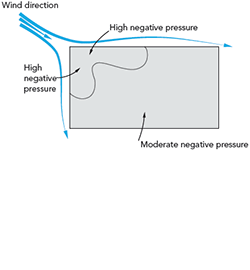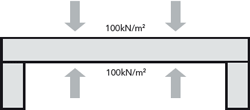Wind load

Effects of wind pressure on a building
When wind strikes a building it is deflected to generate a positive pressure on the windward face. As it accelerates around the side of the building and over the roof it creates a reduced or negative pressure in its trail. The greatest pressures are experienced at the windward corners and edges of the roof, where the negative pressure exerted on the roof can be several times that experienced in the central areas.
Bauder has carried out system specific wind load testing to ensure our products are robust enough to withstand the effects of wind load. These are available upon request; however, we do recommend a project specific wind load calculation is carried out. Bauder Technical Department can provide project specific Wind Load Calculations on request in accordance with the UK National Annex to Eurocode 1 - Actions on structures Part 1 - 4: General actions - Wind actions (BS EN 1991 - 1 - 4).

Critical Layer
When there is no wind, the air pressure on the upper surface of a roof system is the same as that on the underside. Wind changes this equilibrium by reducing the atmospheric pressure on the surface of the roof system.
The atmospheric pressure acting on the underside of the roof will remain the same or may be increased if windows or doors are open on the windward side of the building. The result is a net upward push acting on the underside of the roof. This upward thrust will be exerted on the lowest air impermeable layer in the roof construction, which will be required to stop air flowing further into the system. In most roof constructions there is one layer that provides the dominant barrier against the upward thrusting flow of air and this is referred to as the critical layer.
In roof constructions where the deck is continuous (e.g. screeded concrete) it will be deemed to be the critical layer, but for air permeable decks (i.e. those with joints) the critical layer will occur somewhere in the roof system itself.
In the case of insulated bituminous membrane systems and cold applied liquid systems where the deck is permeable, the critical layer will be the vapour barrier (in a warm roof construction) or the underlayer (in a cold or inverted roof). When these membranes are properly installed, the bond achieved will be far stronger than the loading imposed by wind uplift.
In the case of refurbishment overlays, the critical layer will be the existing roof system and its suitability to perform adequately will need to be given careful consideration. Single Ply membranes can be restrained against wind up lift by either being mechanically fastened or adhered, both methods of attachment provide effective resistance to wind uplift forces.
Both hot melt and uninsulated cold applied liquid systems are fully bonded to the deck and wind uplift is not considered to be a problem.
Inverted Roofs
With an inverted roof specification, the insulation is laid loose and its security will be provided by a loading coat, typically gravel ballast or paving slabs.
Edge Detailing
Damage caused to flat roofs during severe gales usually starts at exposed windward corners and edges. It is therefore important to make sure that fascias, cappings, trims, and drips are adequately fixed. As a rough guide trims should be screw fixed at 250 mm centres with extra fixings added under conditions of extreme exposure.